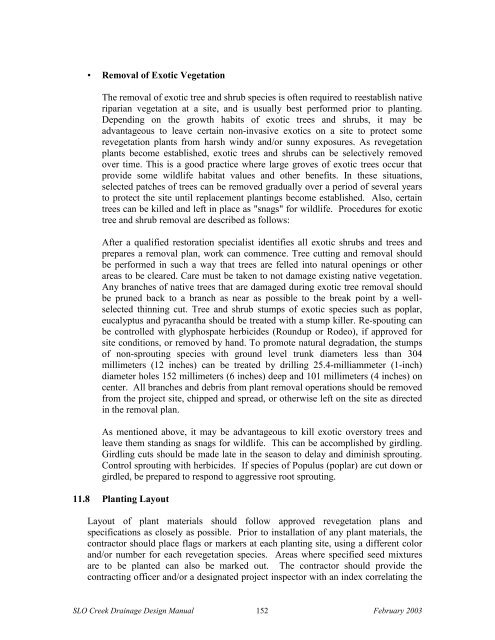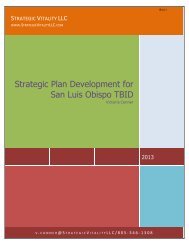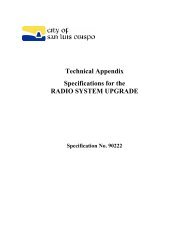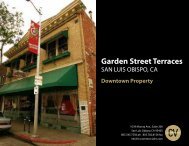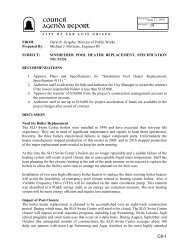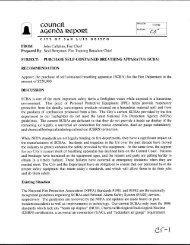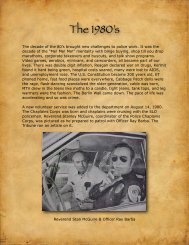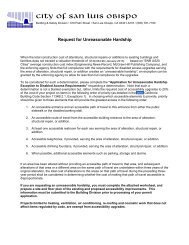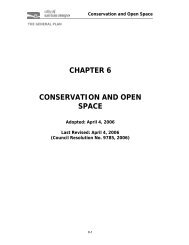Drainage Design Manual - the City of San Luis Obispo
Drainage Design Manual - the City of San Luis Obispo
Drainage Design Manual - the City of San Luis Obispo
You also want an ePaper? Increase the reach of your titles
YUMPU automatically turns print PDFs into web optimized ePapers that Google loves.
• Removal <strong>of</strong> Exotic VegetationThe removal <strong>of</strong> exotic tree and shrub species is <strong>of</strong>ten required to reestablish nativeriparian vegetation at a site, and is usually best performed prior to planting.Depending on <strong>the</strong> growth habits <strong>of</strong> exotic trees and shrubs, it may beadvantageous to leave certain non-invasive exotics on a site to protect somerevegetation plants from harsh windy and/or sunny exposures. As revegetationplants become established, exotic trees and shrubs can be selectively removedover time. This is a good practice where large groves <strong>of</strong> exotic trees occur thatprovide some wildlife habitat values and o<strong>the</strong>r benefits. In <strong>the</strong>se situations,selected patches <strong>of</strong> trees can be removed gradually over a period <strong>of</strong> several yearsto protect <strong>the</strong> site until replacement plantings become established. Also, certaintrees can be killed and left in place as "snags" for wildlife. Procedures for exotictree and shrub removal are described as follows:After a qualified restoration specialist identifies all exotic shrubs and trees andprepares a removal plan, work can commence. Tree cutting and removal shouldbe performed in such a way that trees are felled into natural openings or o<strong>the</strong>rareas to be cleared. Care must be taken to not damage existing native vegetation.Any branches <strong>of</strong> native trees that are damaged during exotic tree removal shouldbe pruned back to a branch as near as possible to <strong>the</strong> break point by a wellselectedthinning cut. Tree and shrub stumps <strong>of</strong> exotic species such as poplar,eucalyptus and pyracantha should be treated with a stump killer. Re-spouting canbe controlled with glyphospate herbicides (Roundup or Rodeo), if approved forsite conditions, or removed by hand. To promote natural degradation, <strong>the</strong> stumps<strong>of</strong> non-sprouting species with ground level trunk diameters less than 304millimeters (12 inches) can be treated by drilling 25.4-milliammeter (1-inch)diameter holes 152 millimeters (6 inches) deep and 101 millimeters (4 inches) oncenter. All branches and debris from plant removal operations should be removedfrom <strong>the</strong> project site, chipped and spread, or o<strong>the</strong>rwise left on <strong>the</strong> site as directedin <strong>the</strong> removal plan.As mentioned above, it may be advantageous to kill exotic overstory trees andleave <strong>the</strong>m standing as snags for wildlife. This can be accomplished by girdling.Girdling cuts should be made late in <strong>the</strong> season to delay and diminish sprouting.Control sprouting with herbicides. If species <strong>of</strong> Populus (poplar) are cut down orgirdled, be prepared to respond to aggressive root sprouting.11.8 Planting LayoutLayout <strong>of</strong> plant materials should follow approved revegetation plans andspecifications as closely as possible. Prior to installation <strong>of</strong> any plant materials, <strong>the</strong>contractor should place flags or markers at each planting site, using a different colorand/or number for each revegetation species. Areas where specified seed mixturesare to be planted can also be marked out. The contractor should provide <strong>the</strong>contracting <strong>of</strong>ficer and/or a designated project inspector with an index correlating <strong>the</strong>SLO Creek <strong>Drainage</strong> <strong>Design</strong> <strong>Manual</strong> 152 February 2003


